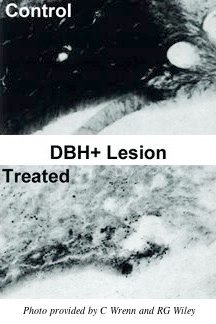Changes in the Secretory Activity of Organs Producing Noradrenaline Upon Inhibition of Its Synthesis in Neonatal Rat Brain. Murtazina, AR, Dilmukhametova, LK, Nikishina, YO, Sapronova, AY, Volina, EV, & Ugrumov, MV. (2017). Russian Journal of Developmental Biology, 48 (5):295-300.
This study demonstrates that synthesis of noradrenaline after destruction of noradrenergic neurons was switched off by stereotactically injecting Anti-DBH-SAP (0.5 μg/2 μL; Cat #IT-03) into the lateral brain ventricle of neonatal rats. Forty-eight hours after treatment, expression of the tyrosine hydroxylase (TH) gene in the brain was 56% higher, 53% higher in the adrenal glands, and 55.8% higher in the organ of Zuckerkandl as compared to control (2 μL of 0.9% NaCl).

Targeting DBH-Expressing Cells
Anti-DBH-SAP is a highly specific noradrenergic lesioning agent that specifically targets cells that express dopamine beta hydroxylase. Unlike other lesioning methods, this molecular lesioning agent assures definitive ablation of the target neurons expressing rat DBH. Permanent and selective removal of cerebral noradrenergic innervation makes an important animal model for the study of drug effects (anti-hypertensives, opiates, stimulants, etc.), behavior (fear, depression, food intake), plasticity of other systems in response to loss, and primary autonomic failure.
